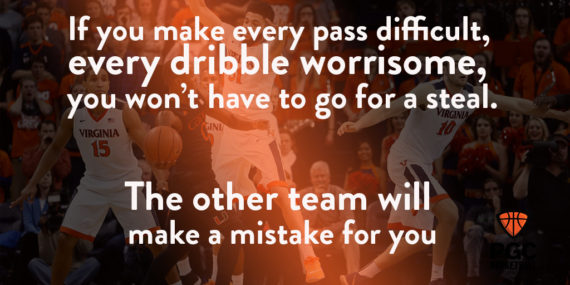How to Make a Game Winning Steal
This defensive maneuver really might get you a game-winning steal someday. Because of the psychology behind it, it has a better chance of working at the end of a game than it does at the beginning when there is no pressure. If you use this play early in a game, you are likely to get out of position, get beaten and get taken out of the game by your coach. It is not good basketball to be lunging for steals early in a game, and since the player with the ball is not likely to be particularly nervous early, this play is not likely to be effective. End-of-game nervousness and that altered psychology of protecting a lead rather than trying to get one is the circumstance under which this works best.

Assume you are behind by a point or two or three, and you are in the closing minutes. At a time like this, you can get away with a steal attempt because the team with the ball is not so intent on taking advantage of a defender momentarily out of position. Their chief concern is running out the clock. So, even if you miss your attempt, you are unlikely to hurt your team, and you may very well get the ball.
You know that any player, even an excellent player, would like to have the ball in his strong hand in pressure situations. Therefore, what you want to do, at the end of a game when you need a steal, is to create very suddenly a pressure situation, and you want to know exactly when you are doing it. If you can surprise the dribbler with the suddenness of the pressure, he will not have time to respond intelligently—he will respond instinctively. His instincts will tell him when he meets sudden, unexpected pressure to get the ball immediately in his strong hand.
Knowing this, you can prepare a response and perhaps beat him to it. Try it like this: Let your man get the ball and pick him up full-court.
Give him a lot of room, and move far over to his strong side, giving him a safe, wide-open path up the court to his weak side.
At first, you are so far from him that he can even advance the ball up court with his strong hand if he wishes, but as he advances the ball, you get a little closer to him, so that he dribbles the ball with his weak (usually left) hand.
At this point, you are in a “token pressure” situation, applying just enough pressure to get that ball in his weak hand but not enough to give him a cause for worry.
You are just close enough that he doesn’t feel safe dribbling with his strong hand, but he still feels very safe dribbling the ball with his weak hand (with his body between you and the ball). It is from this safe, secure position that your steal attempt comes.
At a point you decide on, lunge violently to his weak side. Go from passive to violent in a flash, but don’t go for the ball. This first lunge is only a fake, only to create that sense of sudden, unexpected trouble that makes his response instinctive.
After you make the violent fake, don’t wait for his reaction. Throw your body to his strong side while watching and reaching for his strong hand. There is an excellent chance that he will put the ball right out in front of you as he tries to get it in his strong hand.
This maneuver has won games and gotten steals and certainly is worth trying. Usually, even if your fake or your lunge doesn’t work, there will be time to recover since the player with the ball is not primarily interested in taking advantage of a sudden five-on-four.
You can try out this maneuver in pickup games to get a sense of when to fake and how big to make your fake, but remember, without the same sense of pressure, the dribbler in a pickup game is much more likely to see the weak side path you are giving him and take it aggressively in order to pass you. If he does this, all is not lost. (You may even purposely set up this situation by letting the dribbler think you have been badly beaten.)
If you are ready to run with him, you can catch up and very possibly get a swipe at the ball when he tries to switch to his strong hand and go for the middle of the court.
Related Articles
How To Win The Inner-Game of Basketball (and Life)
As a basketball player, just like so many other walks of life, players do not operate at max capacity because they are extremely hard on themselves and are losing the ‘inner game.’
What Does It Mean To Be Self-Disciplined?
In the game of basketball, self-discipline is a word that all coaches want players to embody on a daily basis. The word ‘Discipline’ is used for some teams as their standard of excellence, for others it is a pillar that their culture is built upon.
A Champion’s Soul
Muhammad Ali famously said “The fight is won or lost far away from the witnesses, behind the lines, in the gym and out there on the road; long before I dance under these lights.”
About PGC
PGC Basketball provides intense, no-nonsense basketball training for players and coaches. Our basketball camps are designed to teach players of all positions to play smart basketball, be coaches on the court, and be leaders in practices, games and in everyday life.
We combine our unique PGC culture with a variety of teaching methods and learning environments to maximize the learning potential of those that attend our sessions. In addition to spending 6-7 hours on the court each day, lessons will be reinforced through classroom sessions and video analysis.
Our goal at PGC is to empower you with the tools to fulfill your basketball dreams, while also assisting you in experiencing the joy of the journey.
To learn more about PGC Basketball, including additional basketball training tips and videos, visit our YouTube Channel or find us on Facebook, Instagram, and Twitter.













Share This Post